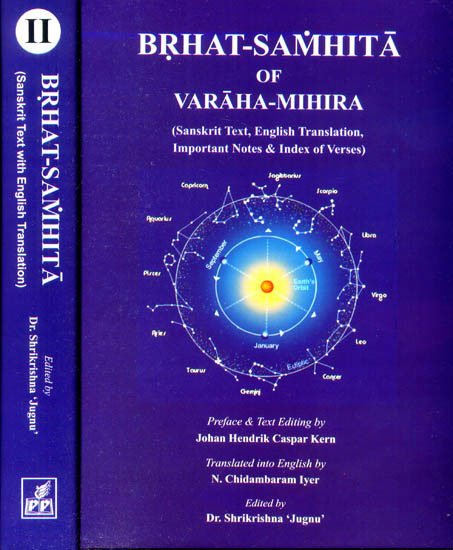Brihat Samhita
by N. Chidambaram Iyer | 1884 | 135,584 words | ISBN-13: 9788171104215
This page describes durable cement (vajralepa-lakshana) which is the fifty-seventh Chapter of the English translation of the Brihat-samhita. This work, written by Varahamihira in the 6th century, is classified as jyotisha literature, also known as Indian astronomy. It contains however, also content regarding astrology, palmistry, agriculture, gardening, perfumes, medicines and various other encyclopedic topics.
Chapter 57 - On durable cement (vajralepa-lakṣaṇa)
[Sanskrit text for this chapter is available]
1-2. Put into a droṇa. of water the raw leaves of the Tinduka and of the Kapittha, the flowers of the Śālmalī, the seeds of the Śallakī,[1] the bark of the Dhanvana,[2] and a small quantity of Vacā; heat the water on fire till it is reduced to one-eighth of its original quantity. Remove the jar from fire.
3. Put into the kalka thus prepared Guggulu,[3] the juice of the Śrīvāsaka[4] and of Sarja and Bhallāta, Kundumka,[5] and the fruit of the Atasī and of Bilva. The paste thus formed is known as Vajralepa.
4. In the construction of temples and of the palaces of kings, of turrets, and in fixing the Liṅga or the image in the temple, in the construction of walls and wells, if the vegetable cement above referred to, be melted and used, the structures will last for a crore of years.
5-6. Form a mixture of shel-lac, the resin of the plant Boswellia thurifera. Bdellium, soot in the ceilings of houses, the fleshy part of the fruit of Kapittha and of Bilva, the fruit of the Nāgabala,[6] Madhūka and Mañjiṣṭha, the juice of the Sarja as well as vinegar made from fruit, and put it in a jar of water, heat it till it is reduced to an eighth of its bulk, the resulting paste is also known as Vajralepa and is an excellent one and can be used for the several purposes already mentioned.
7. Form a mixture of the horns of the cow, the buffalo, and the goat reduced to powder, the hair of the ass. the skin of the buffalo, the mild of the cow and the juice of the Nimba and the Kapittha trees; throw the mixture in a jar of water and heat it, the resulting kalka is also an excellent animal cement.
8. Melt together eight parts of lead, two parts of bronze and one part of brass; the result will be a strong metallic cement. This is according to Maya.
Footnotes and references:
[1]:
Śallakī: The Gum olibanum tree, Boswellia thurifera. Beng. Śalai, Hind. Luban.
[2]:
Dhanvana: The plant Alhagi maurorum. Eng. Hebrew Manna, Hind. Juwasa.
[3]:
Guggulu: Bdellium.
[4]:
The juice of the Śrīvāsaka: turpentine.
[5]:
Kunduruka: the resin of the plant Boswellia thurifera.
[6]:
Nāgabala: the plant Uraria lagopodioides.
